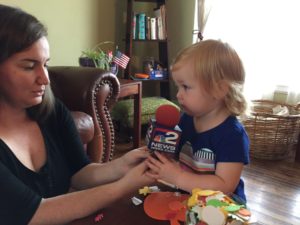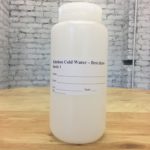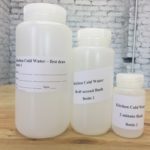Nov 8
2017
Failing kids with lead poisoning
Sherry Slaper was at wit’s end trying to help her lead poisoned daughter.
She followed the orders of the Erie County Health Department by painting over the lead paint on her window sills and staircase, throwing away cheap Chinese toys that can contain traces of lead and obsessively cleaning her Kaisertown apartment. But her daughter’s lead levels did not drop.
“It was a storm of emotions,” Slaper said. “You go from being angry to scared to sad.”
Could it be the water, she thought? To be safe, she installed a water filter on her kitchen faucet. Then — and only then — did her daughter’s lead level decrease.
There is no way to know for sure how her daughter got sick. But Marc Edwards, Virginia Tech University’s civil engineering professor credited with helping uncover the lead in water crisis in Flint, Michigan, said “water is always underestimated.”
Investigative Post subsequently determined through independent testing by Virginia Tech University that Slaper’s tap water had lead at concentrations greater than what is allowed in bottled water, the standard adopted by the City of Buffalo.
Slaper’s situation reflects ongoing problems with the way drinking water providers test for lead in tap water and how the Erie County Health Department downplays the risks.
Most water utilities, including those in Western New York, collect one sample of tap water to test for lead. But Edwards said a more comprehensive sampling of multiple bottles of water produces more accurate results.
In addition, Edwards said water utilities often tell their customers who are concerned about lead to run their faucets for too short a period of time before using the water for drinking or cooking.
Edwards said these flaws can leave people with a false sense of security.
“The utilities and EPA don’t want to talk about it because once you open the can of worms, people aren’t going to trust their water,” he said.
[nm-mc-form fid=”2″]
Experts said testing the drinking water in homes where a child is already lead poisoned is critical. But the Erie County Health Department usually fails to do so. Instead, the department said it began in April referring those cases to the city for testing. But only 15 of 45 referrals were tested by the city, according to county records obtained under the state Freedom of Information Law.
Edwards said there is a simple, cost-effective solution for residents concerned about lead in their tap water: install a filter certified to remove lead.
“For a modest investment of $30, if you buy an NSF-certified filter and use it to clean the water used for cooking and drinking, your worries are over,” he said.
Ground zero for lead poisoning
Lead poisoning is a serious problem in Buffalo, where hundreds of young children are diagnosed each year. The diagnosis could mean a life of learning disabilities, developmental delays and behavioral problems.
An Investigative Post analysis in 2015 found that neighborhoods on the city’s West and East sides accounted for three of the four upstate ZIP codes reporting the most new cases, according to state data for a three-year period ending in 2012. Consequently, Buffalo is Ground Zero for lead poisoning in all of Upstate New York.
The county Health Department has cited peeling and chipping paint as the chief source of exposure for children, including in Buffalo, which has some of the oldest housing stock in the nation.
The department operates two inspections programs to combat lead poisoning. One involves mostly exterior inspections in at-risk neighborhoods on Buffalo’s East and West sides. In response to Investigative Post’s reporting, county officials in May 2016 approved a five-year, $3.5 million plan to boost inspections by hiring five health inspectors and other staff.
It’s a daunting task. There are 85,000 homes in Buffalo at risk for lead paint hazards, including 12,000 with documented lead problems where young children live. The department would need at least two decades to inspect all the at-risk homes, even with the new staff.
The other program involves interior and exterior investigations of homes where a child is already diagnosed with an elevated blood lead level. The environmental investigation “is intended to identify any potential or significant sources of lead to which the child may have been, or may potentially be exposed,” according to the instructions for county health inspectors.
The Health Department’s standard operating procedures for the environmental investigations state that water samples “and other odd items shall be taken only when deemed necessary by Risk Assessor.”
Companion story: Testing to get the lead out
As a result, county health officials rarely collect water samples from homes where a child is already poisoned.
“Why would they not conduct a water investigation to ensure that water is not a source and, if it is, to give parents’ guidance on what to do to prevent additional exposures?” said Yanna Lambrinidou, an environmental health and policy scholar activist in Washington, D.C., who focuses on lead in water.
“This is a system driven by willful ignorance and an ideology that goes against the science and against the mission of every department of health.”
A mother’s efforts
Slaper’s daughter had a blood-lead level high enough to require a full home inspection by the Health Department in 2011 to identify sources of lead.
Health Department inspectors scoured her Kaisertown apartment, finding lead paint on a windowsill, the stairwell and nine other spots outdoors. They also found lead in a soil sample and warned her to keep her child away. To make matters worse, Slaper said her daughter developed an eating disorder that resulted in her chewing on inedible things – possibly paint and soil.
“From what I was told, we didn’t have that many paint violations in our house,” Slaper said. “So we amended those issues immediately and passed a second inspection. But her levels never dropped.”
The more Slaper researched, the more she wondered if her drinking water was part of the problem. She said the Health Department refused to test her water.
“I was reassured by the inspector that the water department has to pass multiple tests and that there was no way it could be the water,” Slaper said.
“I trusted them, I believed them and I really didn’t push the issue.”
Indeed, the Health Department’s inspection report of Slaper’s apartment obtained by Investigative Post through a FOI request shows that officials never collected water samples. The report notes that inspectors found teeth marks on a windowsill and that they gave Slaper cleaning supplies and a pamphlet on how to protect her family.
Slaper paid for her federal certification to remediate lead in her apartment. Subsequently, she addressed all the violations and a private environmental firm deemed her home safe, according to department records. But her daughter’s lead level again spiked.
Only after Slaper installed a faucet filter that removes lead from drinking water did her daughter’s lead-levels begin to progressively drop.
Almost five years after that ordeal, Investigative Post and Virginia Tech tested her tap water. Her test showed the water contained 6.6 parts per billion of lead, above the bottled water standard of 5 parts per billion that Buffalo adopted.
“This is something that could have been tested immediately when I asked for it to be tested and possibly her levels wouldn’t have been so high for so long,” Slaper said.
Tap water is regulated by the EPA’s Lead and Copper Rule. The EPA standard for lead in drinking water is 15 parts per billion, which is triple the Food and Drug Administration’s standard for bottled water. Buffalo Mayor Byron Brown adopted the stricter bottled water standard for the city water’ supply last fall in response to an Investigative Post story.
Although Slaper’s water tested below the EPA threshold, experts warn that the standard does not protect public health.
“There is no safe level of lead exposure,” said Edwards.
Slaper’s experience was not an isolated one.
Distressing experience
The blood-lead level of Nikki Hitchcock’s daughter tested below the threshold that would have required an inspection by the Health Department. She and her husband, Mark, could not figure out how their daughter had been exposed to lead in their West Side home.
She thought her call to the Health Department would result in the agency “pulling out all the stops” to help her figure it out. But Hitchcock described her experience with the department as “distressing.”
“The person that we spoke to told us if we are the homeowners and they found anything that was a risk, they were going to have to cite us,” said Hitchcock, whose toddler was diagnosed in 2016.
“It felt like they were saying ‘we didn’t want to help.’ ”

The blood lead levels of Nikki Hitchcock’s daughter did not drop until they installed a tap water filtering system.
As a result, the Hitchcocks stopped engaging with the Health Department.
Health Commissioner Gale Burstein refused numerous interview requests for this story. She said in a prepared statement that although she could not discuss individual cases, “lead hazard cases do not result in punitive actions unless the owners fail to resolve the problems in a reasonable period of time.”
In addition, she said the department “has limited statutory authority to order abatement of hazards with regard to water when investigating a reported elevated blood lead level.”
Investigative Post tested the Hitchcocks’ water. The results showed their water contained lead at 7.1 parts per billion, above the 5 parts per billion standard for bottled water adopted by the city.
Edwards, the Virginia Tech professor, said, “I start to become pretty concerned” when lead in tap water tests above the bottled water standard.
“The models predict you’re going to elevate your child’s blood lead level somewhat and that’s just not acceptable,” he said.
Because of their test results, the Hitchcocks installed a full-home water filter. Only then did their daughter’s lead-level begin to decrease.
“At the end of the day, if I wouldn’t drink it out of a bottle of water at Wegmans why would I drink it out of my tap? It doesn’t make any sense,” Hitchcock said.
Testing flaws
Edwards and Virginia Tech provided the 22 testing kits to Investigative Post pro bono. We distributed the kits to city residents and shipped them back to Virginia Tech for testing.
Most drinking water providers, including the Buffalo Water Board and the Erie County Water Authority, collect one liter of tap water to test for lead. This method is generally accepted by the EPA.
But Edwards said this testing method is inadequate because not enough water is collected for testing. He provided Investigative Post with kits that included three bottles that total 1.75 liters of water, almost double what most water utilities collect for lead testing.
Of the 22 homes tested, four of them failed to meet the city’s standard. Only one of them would be haved failed using the city’s one-bottle testing method.
In three of four instances, the first and third bottles easily met the city’s standard, but exceeded it on the second bottle.
Edwards said the EPA’s testing method employed by the Buffalo Water Board and most other water providers can give false assurances that the water has insignificant concentrations of lead when the levels may pose a risk.
“That tells you how badly we’re missing the real health threat here,” he said.
OJ McFoy, chairman of the Buffalo Water Board, said the city is preparing to launch a pilot program to collect more tap water from homes they test.
“Where is this coming from in the system? That’s what we want to know,” McFoy said.
Incorrect instructions
Another flaw is the instructions that water providers and health officials often give to people concerned about lead in tap water.
The instructions to run the water for 30 seconds to two minutes before drinking or using for cooking is bad advice, Edwards said,
“If you want to avoid that, you have to flush it at least two minutes,” he said.
McFoy said the city is following EPA protocol with respect to the advice on flushing the water.
“That information we’ve pulled from other cities, as well as the EPA,” he said. “We will take a look at it, but right now that’s what we have and we’re going to see if our empirical data shows different things.”
The Buffalo Water Board has stepped up its testing for lead in water in the past year. The number of homes tested has been tripled and a greater proportion of those sampled are located on the East and West Sides, where the problem is concentrated.
But the Health Department remains resistant to testing the drinking water at homes where children are already diagnosed with unsafe levels of lead in their blood. Referring lead poisoning cases to the city for water testing isn’t enough, the mothers said.
“They need to test every home,” Slaper said.
“How many children in Buffalo right now are suffering from lead poisoning and the mothers don’t know it’s coming from your kitchen sink?”
Concerned about lead in your tap water? There is a cost-effective solution. An NSF-certified water pitcher or faucet filter typically costs less than $50 and reduces lead from drinking water. Make sure to replace the filters in the timeframe recommended by the manufacturer to ensure effectiveness. You can find more NSF-certified products at www.nsf.org



